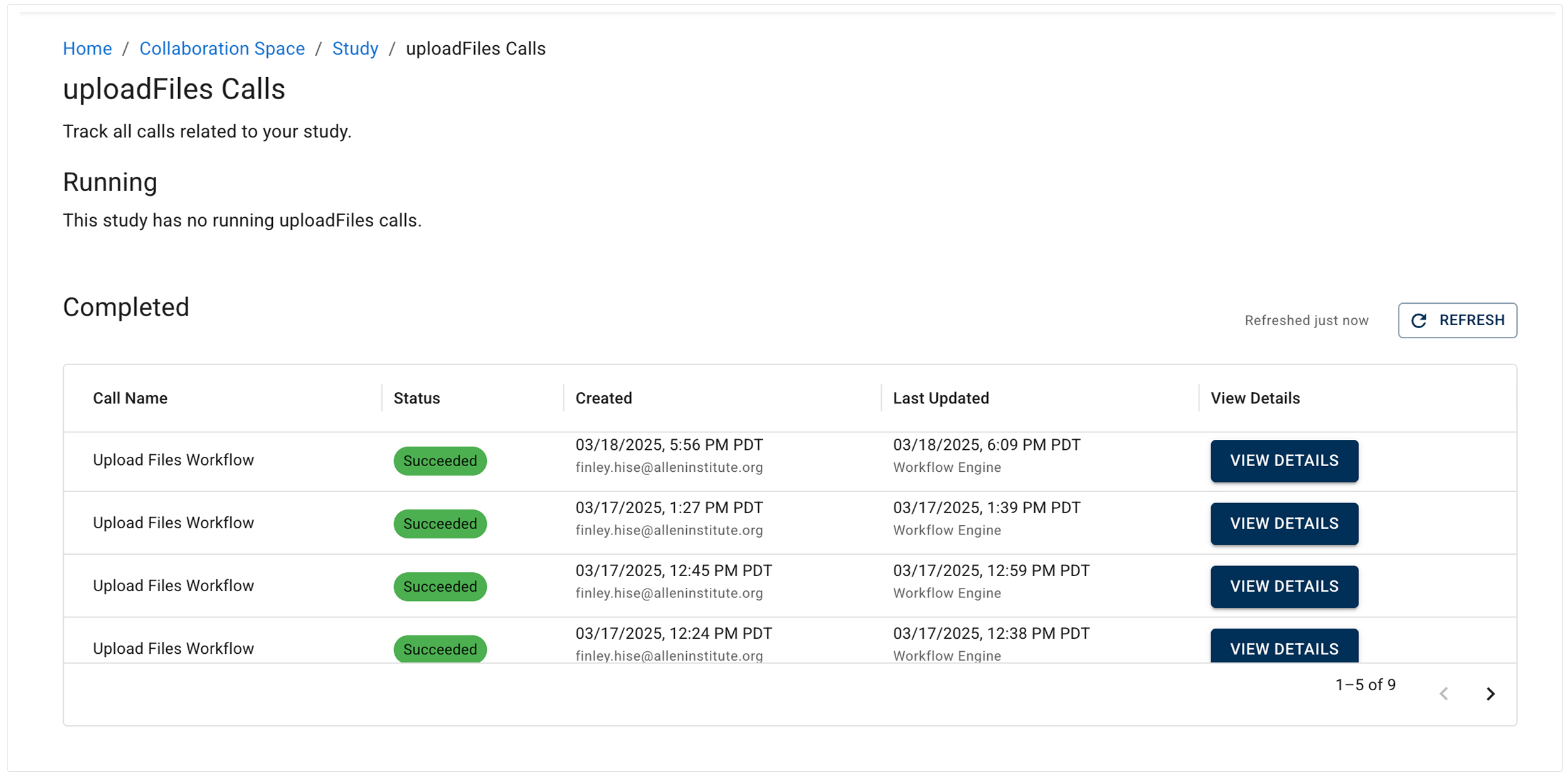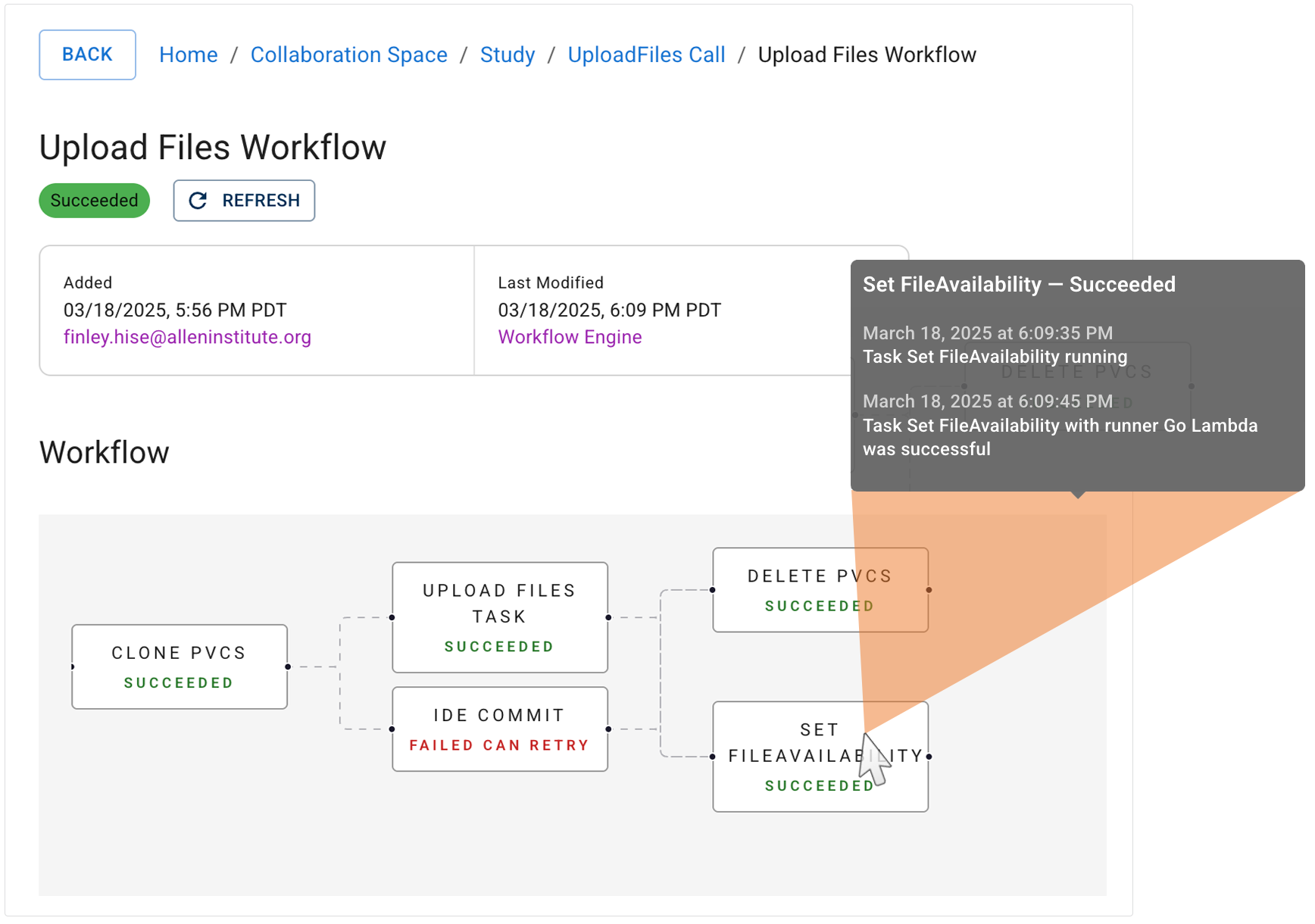Collaboration
Work on studies, share data and visualizations, and publish your findings as a publication or Data App.
Research
Find and access your research, store intermediate files, manage IDE state, and save results or visualizations.

![]()
What's New?
2025-12-16
New Upload Files Workflow UI to Support Fast Mode
The new upload files workflow UI improves visibility into upload_files (Python) | uploadFiles (R) calls for IDE instances associated with studies. This improvement supports the new Fast Mode option for upload files. However, you need not have Fast Mode enabled to use the new UI—it appears with every upload files call.
IDE Instances Page
A banner displays the number of upload files calls you're currently running:
A REFRESH button on the banner updates the count and shows the time elapsed since last the refresh (but does not retry the call).
A VIEW ALL CALLS button on the banner opens a list of upload files workflows for the associated study.

Upload Files List View
This view lists all upload files calls associated with a given study.
It includes the status and the date/time created and last modified (and by which user or service).
A VIEW DETAILS button in each row links to a workflow details view.

Workflow Details View
This graphic view of the workflow shows each step and its status, such as UPLOAD FILES TASK (SUCCEEDED) or IDE COMMIT (FAILED CAN RETRY).
It also shows when the upload files call was added and last modified (and by which user or service).
Hovering over a node displays logs showing subtasks with human-readable timestamps and the names of services used to execute each subtask.

2025-12-09
File Uploads Accelerated and New SDK Capabilities Launched
Uploads and SDK operations are now faster, more transparent, and easier to troubleshoot.
- A new fast mode in
upload_files()|uploadFilescuts the typical upload time from 15–25 minutes down to 3–5 minutes by skipping the Conda build step. - The SDK now provides enhanced logging, as shown in the following example.

- Additional structured logs and clearer error messages are available for all methods.
ProjectGuidnow automatically attaches to alldata.frameobjects fromread_samples()|readSamples(),read_files()|readFiles(), andget_file_descriptors|getFileDescriptors.getFileDescriptors()supports lists of filter values, as in the following example, and performs significantly faster for large queries.

upload_file_to_private_folder()|uploadToPrivateFoldernow runs asynchronously, reducing wait time.- Improved validation prevents upload failures caused by empty
environment.ymlfiles. - Additional prompt reminders, such as the following example, appear in
upload_files()|uploadFileswheninput_sample_idsare not provided.
"Please provide input of comma separated sample ids for the files being uploaded: " |
2025-10-31
HISE Collaboration Space Revamp
We’ve overhauled the HISE Collaboration Space UX/UI to foster teamwork and enhance flexibility. You’ll notice a cleaner workspace, streamlined navigation, smarter permissions, and more robust tools for managing studies.
Key Features
|
|
|
|
|
|
New SDK User Documentation
A new document, Use the Cache Files SDK Method (Tutorial), explains how to use the cache_files() SDK method to download HISE files and store them in your IDE’s cache directory.
2025-10-16
HISE Ingest Agent Update
The following two ingest agent updates improve HISE performance:
The agent now accommodates more precise queries, reducing the number of records that must be read in from SLIMS.
- The ingest agent now updates HISE records only when the necessary fields have changed in SLIMS.
2025-09-24
IDE Stacking Feature Released
Stack multiple IDEs like a digital deck of cards to keep related instances together for better visibility and data tracking. Learn how to create, edit, clone, move, dissolve, or delete IDE stacks with our user guide: Create an IDE Stack (Tutorial).
Traceability Feature Launched
Now you can "walk the graph" to display CertPro nodes and explore their immediate neighbors (inputs and outputs) one step at a time, instead of rendering the entire graph at once.
File Availability Lag Time Significantly Reduced
We've significantly reduced the time it takes for your files to appear in Advanced Search after calling uploadFiles() or dropping files into a watchfolder. Most files are now available almost instantly in the Advanced Search UI.
</h1<small>